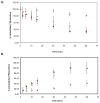A pharmacogenetic candidate gene study of tenofovir-associated Fanconi syndrome
- PMID: 25485598
- PMCID: PMC4331349
- DOI: 10.1097/FPC.0000000000000110
A pharmacogenetic candidate gene study of tenofovir-associated Fanconi syndrome
Abstract
Background: Tenofovir disoproxil fumarate (TDF) is a widely used antiretroviral agent with favorable efficacy, safety, and tolerability profiles. However, renal adverse events, including the rare Fanconi syndrome (FS), may occur in a small subset of patients treated for HIV infections.
Objectives: The aim of this study was to identify genetic variants that may be associated with TDF-associated FS (TDF-FS).
Methods: DNA samples collected from 19 cases with TDF-FS and 36 matched controls were sequenced, and genetic association studies were conducted on eight candidate genes: ATP-binding cassette (ABC) transporters ABCC2 (MRP2) and ABCC4 (MRP4), solute carrier family members SLC22A6 (OAT1) and SLC22A8 (OAT3), adenylate kinases 2 (AK2) and 4 (AK4), chloride transporter CIC-5 CLCN5, and Lowe syndrome protein OCRL. The functional effects of a single nucleotide polymorphism (SNP) predicted to alter the transport of tenofovir were then investigated in cells expressing an identified variant of ABCC4.
Results: The case group showed a trend toward a higher proportion of rare alleles. Six SNPs in ABCC2 (three SNPs), ABCC4 (one SNP), and OCRL (two SNPs) were associated with TDF-FS case status; however, this association did not remain significant after correction for multiple testing. Six SNPs, present in OCRL (four SNPs) and ABCC2 (two SNPs), were significantly associated with increased serum creatinine levels in the cases, and this association remained significant after multiple test correction (P < 2 × 10). One synonymous SNP in ABCC2 (rs8187707, P = 2.10 × 10, β = -73.3 ml/min/1.73 m(2)) was also significantly associated with the decreased estimated glomerular filtration rate of creatinine among cases. However, these results were driven by rare SNPs present in a small number of severely affected cases. Finally, a previously uncharacterized, nonsynonymous SNP, rs11568694, that was predicted to alter MRP4 function had no significant effect on tenofovir cellular accumulation in vitro.
Conclusion: Although no single predictive genetic marker for the development of TDF-FS was identified, the findings from our study suggest that rare variants in multiple genes involved in the renal handling of tenofovir, and/or renal cell homeostasis, may be associated with increased susceptibility to TDF-FS.
Conflict of interest statement
Figures



Similar articles
-
Association between ABCC2 gene haplotypes and tenofovir-induced proximal tubulopathy.J Infect Dis. 2006 Dec 1;194(11):1481-91. doi: 10.1086/508546. Epub 2006 Oct 26. J Infect Dis. 2006. PMID: 17083032
-
Fanconi syndrome accompanied by renal function decline with tenofovir disoproxil fumarate: a prospective, case-control study of predictors and resolution in HIV-infected patients.PLoS One. 2014 Mar 20;9(3):e92717. doi: 10.1371/journal.pone.0092717. eCollection 2014. PLoS One. 2014. PMID: 24651857 Free PMC article.
-
Predictors of kidney tubular dysfunction in HIV-infected patients treated with tenofovir: a pharmacogenetic study.Clin Infect Dis. 2009 Jun 1;48(11):e108-16. doi: 10.1086/598507. Clin Infect Dis. 2009. PMID: 19400747
-
Pharmacogenetics of tenofovir treatment.Pharmacogenomics. 2009 Oct;10(10):1675-85. doi: 10.2217/pgs.09.115. Pharmacogenomics. 2009. PMID: 19842939 Review.
-
Efficacy and safety of the regimens containing tenofovir alafenamide versus tenofovir disoproxil fumarate in fixed-dose single-tablet regimens for initial treatment of HIV-1 infection: A meta-analysis of randomized controlled trials.Int J Infect Dis. 2020 Apr;93:108-117. doi: 10.1016/j.ijid.2020.01.035. Epub 2020 Jan 25. Int J Infect Dis. 2020. PMID: 31988012 Review.
Cited by
-
Reversal of Proximal Renal Tubular Dysfunction after Nucleotide Analogue Withdrawal in Chronic Hepatitis B.Biomed Res Int. 2017;2017:4327385. doi: 10.1155/2017/4327385. Epub 2017 Oct 29. Biomed Res Int. 2017. PMID: 29214169 Free PMC article.
-
Data on single-step purification method for dye-labeled DNA sequencing.Data Brief. 2016 Feb 27;7:873-6. doi: 10.1016/j.dib.2016.02.050. eCollection 2016 Jun. Data Brief. 2016. PMID: 27077088 Free PMC article.
-
An Exploratory Pharmacogenetic Pilot Study of Two Reverse Transcriptase Inhibitors, Tenofovir Alafenamide Fumarate and Tenofovir Disoproxil Fumarate.Drugs R D. 2025 Jun;25(2):153-160. doi: 10.1007/s40268-025-00509-6. Epub 2025 May 25. Drugs R D. 2025. PMID: 40413716 Free PMC article.
-
Molecular Mechanisms for Species Differences in Organic Anion Transporter 1, OAT1: Implications for Renal Drug Toxicity.Mol Pharmacol. 2018 Jul;94(1):689-699. doi: 10.1124/mol.117.111153. Epub 2018 May 2. Mol Pharmacol. 2018. PMID: 29720497 Free PMC article.
-
A randomized, double-blind, double-dummy, controlled, multicenter study of Qingzhong (tenofovir disoproxil fumarate) versus Viread for the treatment of chronic hepatitis B: First-stage results at week 48.Medicine (Baltimore). 2019 Aug;98(33):e16778. doi: 10.1097/MD.0000000000016778. Medicine (Baltimore). 2019. PMID: 31415381 Free PMC article. Clinical Trial.
References
-
- Services DoHaH. Available from: http://aidsinfo.nih.gov/ContentFiles/AdultandAdolescentGL.pdf.
-
- Gallant JE, Winston JA, DeJesus E, Pozniak AL, Chen SS, Cheng AK, et al. The 3-year renal safety of a tenofovir disoproxil fumarate vs. a thymidine analogue-containing regimen in antiretroviral-naive patients. AIDS. 2008;22(16):2155–63. - PubMed
-
- Society EAC. Available from: http://www.europeanaidsclinicalsociety.org/images/stories/EACS-Pdf/EacsG....
-
- Liver EAFTSOT. EASL clinical practice guidelines: Management of chronic hepatitis B virus infection. J Hepatol. 2012;57(1):167–85. - PubMed
Publication types
MeSH terms
Substances
Grants and funding
LinkOut - more resources
Full Text Sources
Medical
Molecular Biology Databases
Miscellaneous

